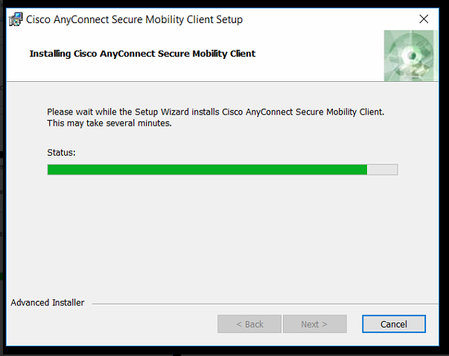| This article refers to the Cisco AnyConnect VPN. If you're looking for information on the Prisma Access VPN Beta that uses the GobalConnect app, see: Prisma Access VPN Landing Page. If you're not sure which service you're using, see: How do I know if I'm using the Cisco AnyConnect VPN or the Prisma Access VPN? |
The following issues were found when testing the Cisco AnyConnect VPN in the MIT environment. For issues identified by the vendor, see Cisco Systems' Release Notes for Cisco AnyConnect VPN Client
When installing and using the Cisco AnyConnect Secure Sockets Layer Virtual Private Network (SSLVPN) client problems may occur. This document will help diagnose and solve potential issues that may be encountered. Use the links below to jump to a topic or scroll down to read all of the topics. Installing the SSLVPN Client. When installing the Cisco AnyConnect Secure Mobility Client, errors may occur and troubleshooting may be needed for a successful setup. Note that the errors discussed in this document is not an exhaustive list and varies with the configuration of the device used.

- Many times the VPN auto-installer does not succeed in installing VPN software on the first try due to how the installer looks for certificates and when the site is added to your list of trusted sites. Click retry at least once before giving up and manually installing the software. It frequently works on the second attempt.
- When connecting to the VPN, all network connections will become severed for a few seconds. This means that programs which rely on a persistent network connection (e.g., instant messaging programs, file transfer programs) may lose their connection and you may need to manually reconnect some programs. Therefore, it is recommended that you close any open applications prior to launching VPN.
- Starting or stopping the VPN will disrupt existing SSH sessions. This happens because the VPN changes your computer's IP address. Make sure you log out of any SSH sessions before starting or stopping the VPN.
- Upon reconnecting to the VPN from off campus, you may be prompted for Kerberos tickets even though you already obtained them. You may also see the 'Lost contact with the security gateway' error message. When the VPN connection is started the IP address list on the machine will change, which may invalidate the tickets. If the tickets cannot be renewed automatically by the Leash program, you will be prompted to obtain new tickets which are valid for the VPN connection.


- Accessibility issue: Screen reader users must use Internet Explorer to successfully run the web-based VPN service. The web-based VPN service does not support screen readers with other browsers.
- Not connecting on some Mac OSX versions, is a problem caused by a space in the user home folder. More info: [hd:AnyConnect Cisco VPN - percent signs]Note: this link contains internal material only accessible by Help Staff at MIT.
See Also
Table of Contents
Some USC online-based services require access through on-campus USC Secure Wireless or a wired network connection. USC offers a Virtual Private Network (VPN) connection to provide secure remote access to these services when you are off-campus. When off-campus, you must use the Cisco AnyConnect VPN client to access internal USC systems handling confidential or sensitive data, such as Student Information System (SIS), and file servers for specific schools and departments. The Cisco AnyConnect Secure Mobility client is a web-based VPN client that does not require user configuration.
This webpage provides instructions on how to install and connect to the Cisco AnyConnect Secure Mobility client for Windows 10 operating systems, including both 32- and 64-bit versions.
Login and Download VPN Software
- Connect to your local network.
- Go to https://vpn.usc.edu/.
- On the login screen, enter your USC NetID and Password.
- Click Login.
- After you have logged in, click AnyConnect on the left.
- In the middle of the screen, click Start AnyConnect.
- On the following Download & Install screen, click the Download for Windows button. You may be prompted to save the file, or it may automatically download to your Downloads folder.

Install AnyConnect VPN Client
- Search for the downloaded file on your computer and double-click it.
- You may see the file in the bottom left-hand corner of your screen.
- If you do not see it there, look in your Downloads folder.
- A Cisco AnyConnect Secure Mobility Client Setup pop-up window appears. Click Next. This will initiate the installation.
- On the End User License Agreement window, select I accept the terms in the License Agreement.
- Then click Next.
- Click Install. The installation will begin.
- If prompted to allow the installation, click Yes.
- If prompted, enter your computer’s Admin ID and password. This is the ID and password you use to log into the computer.
- When the installation is complete, click Finish.
Connect with AnyConnect VPN
- Search for the Cisco AnyConnect Secure Mobility Client app on your desktop (Type “Cisco AnyConnect” in your computer search bar OR select the Windows Start button and search in the menu items).
- Click to open the application.
- In the VPN pop-up window, enter: vpn.usc.edu
- Then click Connect.
- On the Welcome screen enter your USC NetID and Password.
- Click Sign in.
- On the Please verify your identity screen, click on Send Me a Push, Call Me, or Enter a Passcode to complete the Duo Two-Factor Authentication (2FA) process.
- You are now connected to the USC network through the Cisco AnyConnect VPN client.
Getting Help
Cisco Anyconnect Vpn Client Installation Problems 2017
If you need help installing or connecting to your Cisco AnyConnect Secure Mobility client, contact the ITS Customer Support Center.